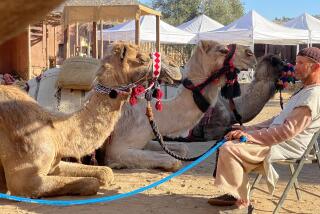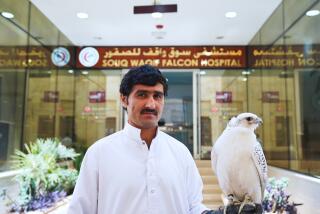Jockeying for a Place in Modern Life
- Share via
AL SHAHHANIYA, Qatar — The whistle blows and a dozen Arabian camels, snorting and straining, begin galloping down a sandy track under a blistering sun.
Camel handlers, who brought the braying and moaning animals to the starting line, scurry to keep from being trampled or kicked. Barefoot, pint-sized jockeys hold on for dear life and maneuver for position as the pack surges forward and quickly is out of sight.
As the Persian Gulf region rushes headlong into modernity with satellite communications and international business deals, the ancient sport of camel racing is enjoying a renaissance. But even it is being updated for the 21st century.
“Camel racing is part of us, something everyone can enjoy,” said Mana Qahtani, a TV commentator at a recent Friday race held here at the conclusion of midafternoon Islamic prayers.
Dubai, in the United Arab Emirates, is the center of camel racing enthusiasm. The televised races in early spring are said to engender as much enthusiasm as the March Madness caused by the college basketball finals in the U.S.
The sheik of Dubai reportedly owns 10,000 camels; a camel hospital there has swimming pools for camels undergoing therapy. A dozen new racetracks have been built in the region in the last decade. And a breeding female recently sold in Dubai for more than $2 million.
The Qatari emir, Sheik Hamad ibn Khalifa al Thani, is promoting camel races as a way to honor tradition while continuing a Western-leaning drive toward modernization. At his direction, a sprawling facility for housing and training camels recently opened adjacent to the track here at Al Shahhaniya, in the vast desert outside the capital, Doha. The sheik and his family are frequent spectators.
Although wagering is banned in these Muslim countries, interest in the races is spiked by handsome prizes offered by the ruling sheiks. First place in a highly publicized race can pay $1 million or more.
“It is like any sport, like your Super Bowl--when there is more money, there is more interest,” Qahtani said.
Beyond the big prizes and high-tech facilities, camel racing even has a touch of scandal.
The United Nations and human rights groups in Britain and Pakistan have decried the trafficking in camel jockeys--some as young as 4. In some instances, boys from Pakistan and Bangladesh have been kidnapped and forced into servitude as jockeys. In other cases, impoverished families have sold their children to middlemen who indentured them to the racing industry.
A report issued in March by the State Department on human rights practices concluded of Qatar: “Guardians and handlers, who often pose as parents, bring the children into the country and supervise their training. They live in difficult conditions and train on a daily basis to become riders.”
Stung by the criticism, the Emirates Camel Racing Foundation, which supervises racing in the region, has promised a ban on riders younger than 14. The United Arab Emirates has vowed to enforce a 1993 law barring underage jockeys. And Qatar’s Supreme Council for Family Affairs has said eliminating “camel kids” is a priority; it has launched a public relations campaign warning camel owners not to hire the very young.
Though cause for concern, the scandal has not diminished the popularity of camel racing--if television coverage is any barometer.
At the races here, two camera crews followed the camels from inside the five-kilometer oval track, providing split-screen images of the leaders and the rest of the pack.
Races are shown tape-delayed on Qatari television, sometimes for several nights running. “People cannot get enough of it,” said Rajab Ali Abaei, an official with the Heyen Racing Committee, which organizes the races. On one recent day, most of the handlers and jockeys were Bedouins from Sudan, who have been camel masters for centuries. The jockeys wore faded silks and headgear that looked like skateboard helmets.
Races are divided according to the age and sex of the camels, which can be 6 feet high at the shoulder and weigh 1,500 pounds. Among younger animals, males are faster; later in life, females often have the edge.
Without individual stalls at the starting line, the one-hump dromedaries and their handlers jostle for position as post time nears. The jockeys are hoisted onto the camels’ backs at the last moment, sitting behind the hump on small blankets.
The start is controlled chaos, with camels bumping and bawling, the jockeys applying tiny whips to the animals’ shoulders, and the handlers racing for safety. Those who get kicked or stepped on are scooped up by a waiting ambulance.
The animals start fast, then settle into the rolling gait that earned them the nickname “ships of the desert.” Smart jockeys wait until the finish to urge the beast for more speed. A race takes about 10 minutes.
Several dozen Land Cruisers, Land Rovers and Escalades race alongside the camels, inside the track. In the SUVs are male members of the Qatari upper class, camel racing fans all.
There is no grandstand like at an American horse racing track, but for Qataris unwilling to wait for the television coverage--and unable to ride along--the TV pictures are immediately beamed into a structure that looks like an American portable classroom. Fans sit inside, sipping sweet tea, cheering their favorites.
“Camel racing is part of our past,” said Abdul Lootah, an international business consultant who was watching the races. “It reminds us who we are.”
More to Read
Sign up for Essential California
The most important California stories and recommendations in your inbox every morning.
You may occasionally receive promotional content from the Los Angeles Times.










